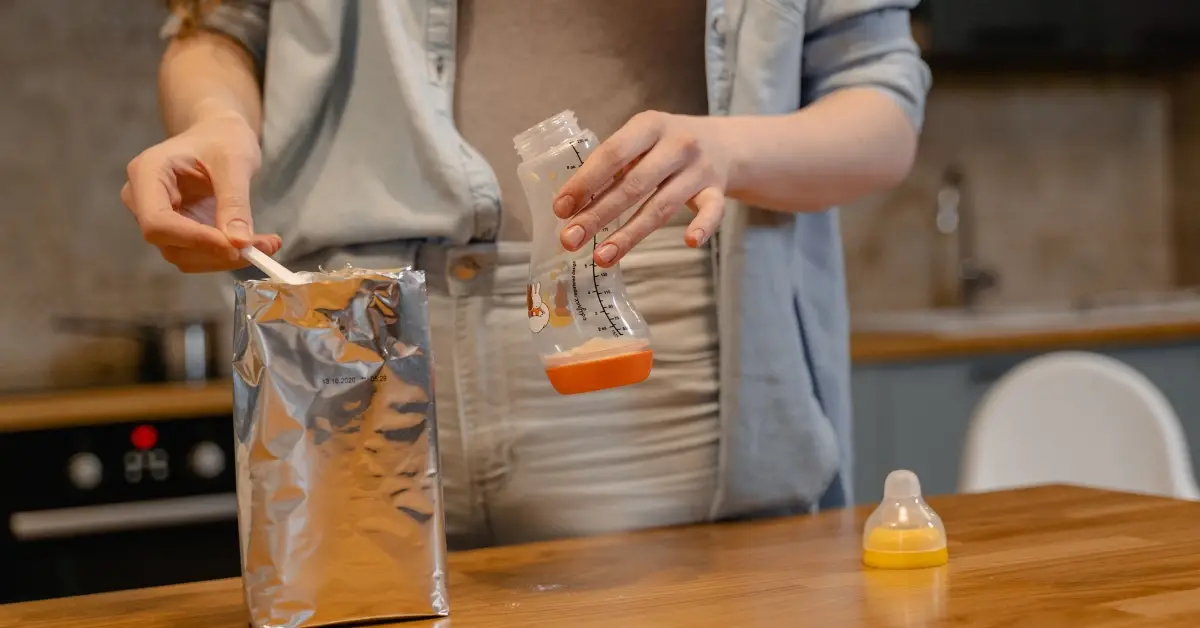Find out how you can switch from Similac to Enfamil, and vice versa, without causing stomach pain in your baby. Get the pro tips on what you need to do!
The products mentioned on this page were independently selected by Babycious editors. As an Amazon Associate, Babycious may earn a commission from qualifying purchases.

Photo by MART PRODUCTION
Both Similac and Enfamil are top leading baby formula brands on the market. Many moms swear by one of those brands, without having tested the other. The truth is, all baby formulas on the US market have to meet the same standards laid out, by the Food and Drug Administration (FDA). So, no matter which brand you choose, your baby will get all the nutrients they need to develop and thrive.
In this article, we won’t be recommending one brand over the other, but rather, provide some key tips on how to switch from Similac to Enfamil (or vice versa), without disrupting your baby’s digestive system. Many parents go with Similac simply because it was the default baby formula available at the hospital where their baby was born. Personally, even though I chose to breastfeed my daughter, I got offered Similac Pro Advance as a “backup” solution, in case I needed it.
If you are considering switching from Similac to Enfamil (or any other baby formula brand), it might be because you feel that your baby is having trouble with gas, constipation, or spit-ups. Maybe you simply are worried about the recent recalls of Similac products. No matter the reason, you should know that it’s possible to make the switch without any major disruptions.
Sticking to One “type” of Formula
The common wisdom when it comes to formula feeding is that you pick one brand of baby formula and stick with it. But this is not actually accurate. Switching baby formula brands is absolutely fine as long as it is the same type of formula. For example, you can switch from standard milk-based formula to another standard milk-based formula without any problems. That’s because both formulas have a similar nutritional profile and will not upset your baby’s tummy.
The same goes for gentle baby formulas or hypoallergenic formulas. If your baby is doing well on Similac Pro-Total Comfort formula, for example, then you can feel confident switching to Enfamil Gentlease without any issues. In fact, many parents find that their baby does better on a different brand of the same type of formula.
Here is a breakdown of the main types of baby formulas available on the market:
- Standard Milk-Based Formula: this is the most common type of baby formula. It is made with cow’s milk that has been processed to make it safe for babies. It is a good source of protein, fat, carbohydrates, vitamins, and minerals.
- Gentle Formula: this type of formula is made for babies who have trouble digesting milk proteins. It is easier on the tummy and can be a good alternative to milk-based formulas.
- Formula for spit-up: this type of formula is made for babies who spit up frequently. It is thickened, usually by adding rice starch, and can help reduce the frequency of spit-ups.
- Formula for lactose sensitivity: this type of formula is made for babies who have trouble digesting lactose, the sugar found in milk.
- Hypoallergenic Formula (also known as elemental formula): this type of formula is made for babies who have food allergies or colic. It is made with a protein that has been partially broken down into smaller ones, making it easier to digest.
So to Which Enfamil Formula Should You Switch?
Based on the current type of Similac formula you are feeding your baby, here are the Enfamil counterparts that are the most suitable for a seamless switch:
| Type of formula | Similac | Enfamil |
|---|---|---|
| Standard milk-based The standard type of formula that is milk-based and iron-fortified for baby’s first year | Similac Advance | Enfamil NeuroPro |
| Gentle baby formulas Contain easy-to-digest proteins for babies who don’t tolerate milk-based formulas | Similac Pro-Total Comfort | Enfamil Gentlease |
| Fussiness or gas formulas Easy to digest milk-based formulas designed for babies with lactose sensitivity | Similac Sensitive | Enfamil NeuroPro Sensitive |
| Spit-up baby formulas Contain added rice starch to reduce frequent spit up | Similac for Spit-Up | Enfamil A.R. |
| Formulas for Food allergies Hypoallergenic formulas for food allergies and colic | Similac Alimentum | Enfamil Nutramigen |
Making the Switch from Similac to Enfamil Formulas
Now that you know it is possible to switch baby formula brands without any problems, and which Enfamil formula is the most similar to the Similac one your baby is currently taking, here is how to introduce the new formula to your baby with the least amount of disruption:
Introduce the New Formula Gradually
Switching to the new formula all at once may be a shock to your baby’s digestive system and may cause it to rebel! This could result in vomiting, diarrhea, colic, or even a rash.
Instead, start by mixing the new formula with the old one. First, use 1/4 of new formula mixed with 3/4 of the old one. Then, over the course of a few days, gradually increase the amount of new formula while decreasing the amount of old formula. By the end of the week, your baby should be completely transitioned to the new formula.
Mixing the formulas slowly will prevent your baby from having a reaction to the new formula, and will help them get used to the new taste. If you notice that your baby is having trouble with the switch, or if they seem to be uncomfortable, go back to the previous ratio of formulas and try again in a few days.
Related: Holding Baby Upright After Feeding: When To Stop?
Follow the Package Dosage Instructions
When mixing the new formula with the old one, be sure to follow the package dosage instructions for each brand. This will ensure that your baby is getting the right amount of nutrients and will help prevent any tummy troubles.
You might be tempted to add an extra scoop of the new formula to make the transition go faster, but that is never a good idea! Your baby’s tummy is still developing and can’t handle a mixture that is too concentrated (or too diluted). If your baby doesn’t get enough water through daily feeding, it could lead to constipation issues or dehydration.
About Similac Recalls
There have been recent recalls of some Similac products by Abbott Nutrition. However, these products have all been pulled from store shelves and are no longer available for purchase.
If you have boxes of Similac formula and are worried that they may be part of a recall, you can check the lot numbers (a multidigit number on the bottom of the container) against the ones listed on the FDA website, or enter the product lot code on the company’s website.
Bottom Line
Switching from Similac to Enfamil formulas should be easy and can be done without disrupting your baby’s digestive system. Be sure to follow the package dosage instructions and introduce the new formula gradually to avoid any tummy trouble. If you have any questions or concerns, always speak to your baby’s doctor.
Have you ever had to switch baby formula brands? How did it go? Share your experiences in the comments below!
The purpose of this article is informative and educational only. It’s not a substitute for medical consultation or medical care. We do not accept any responsibility for any liability, loss, or risk, personal or otherwise, incurred as a consequence, directly or indirectly, from any information or advice contained here. Babycious may earn compensation from affiliate links in this content.


